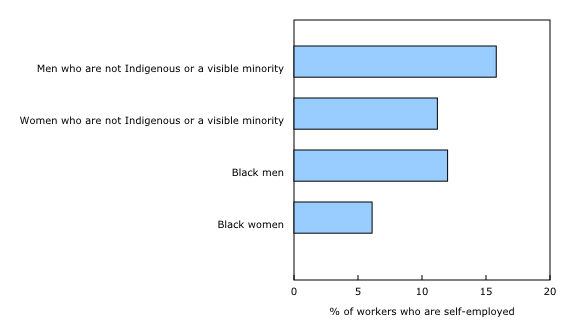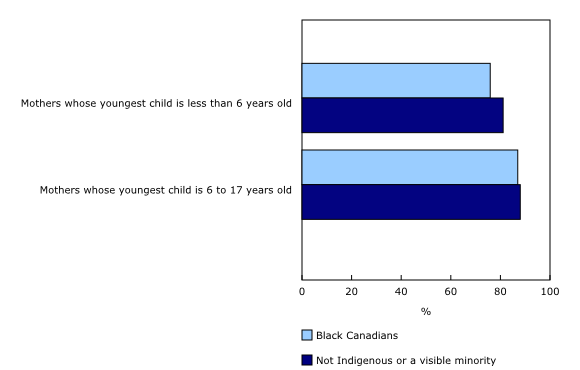Study: A labour market snapshot of Black Canadians during the pandemic
Archived Content
Information identified as archived is provided for reference, research or recordkeeping purposes. It is not subject to the Government of Canada Web Standards and has not been altered or updated since it was archived. Please "contact us" to request a format other than those available.
Released: 2021-02-24
In the context of the COVID-19 pandemic, many Canadians, including Black Canadians, have experienced significant economic hardship, while others put themselves at risk through their work in essential industries such as health care and social assistance.
To mark Black History Month, Statistics Canada is looking at how the 1 million Black Canadians aged 15 to 69 are faring in the labour market during one of the most disruptive times in our economic history. Analysis of the recent labour market situation of population groups designated as visible minorities is now possible as a result of a new question added to the Labour Force Survey (LFS) in July 2020.
Unless otherwise stated, all data in this release are unadjusted for seasonality and are based on three-month averages ending in January 2021.
A snapshot of Black Canadians today
Central Canada home to over four-fifths of Black Canadians
Of the 1.0 million Black people aged 15 to 69 who were living in Canada in January 2021, four-fifths (79.5%) were in Ontario (0.5 million) and Quebec (0.3 million).
Over one-quarter of Black Canadians in this age group were born in Canada (27.1%), and two-thirds (66.3%) are immigrants. In comparison, almost three-quarters (73.6%) of all other Canadians who belong to population groups designated as visible minorities are immigrants.
The Black population in Canada is relatively young, as over four-fifths (85.8%) of 15- to 69-year-olds are younger than 55, compared with two-thirds (68.4%) among Canadians who are not a visible minority (see note to readers).
Black Canadians more likely to hold a university degree than Canadians who are not a visible minority
While having a university degree in Canada is generally associated with a higher employment rate and higher earnings, some groups may face barriers related to the accreditation of degrees earned overseas, skill mismatches or discrimination.
In January 2021, Black Canadians in the core-aged group of 25- to 54-year-olds were more likely to hold a bachelor's degree or higher (42.8%) than Canadians in the same age group who were not a visible minority (33.6%). However, Black Canadians with a university degree had a lower employment rate (86.1%) than their non-visible minority counterparts (91.1%).
While Black men (43.3%) and women (42.3%) aged 25 to 54 were equally likely to have a university degree, a higher proportion of non-visible minority women had a university degree (39.1%) compared with non-visible minority men (28.4%).
Black and non-visible minority men are found in equal measure in the trades and in natural sciences but not at the management table
Black men worked across the economy and in a variety of occupations in January 2021.
A comparable share of employed Black and non-visible minority men worked as tradesmen, or transport or equipment operators (27.5% compared with 27.4%), and in natural and applied sciences (12.0% compared with 11.9%). Black men were about 40% less likely to work in management occupations than non-visible minority men (6.3% compared with 11.3%).
Employed Black women were also underrepresented in management occupations (4.3%) compared with non-visible minority women (6.9%).
Black Canadians less likely to be self-employed
Some population groups face greater barriers to self-employment and entrepreneurship than others, or are more concentrated in industries or occupations where this type of work is less common.
Employed Black Canadians (9.1%) were less likely to be self-employed than non-visible minority Canadians (13.6%) overall in January 2021. At the same time, the self-employment rate among Black men (12.0%) was nearly twice as high as the rate for Black women (6.1%).
How are Black Canadians faring in the labour market during the pandemic?
Black Canadians face high unemployment during the pandemic
Differences in the unemployment rates of diverse groups of Canadians are attributable to a number of factors, including long-term trends, the age of the population and the unequal impact of COVID-19 on certain sectors of the economy.
Black Canadians experienced a higher unemployment rate than non-visible minority Canadians in the recent past. For example, 12.5% of Black Canadians in the labour force were unemployed at the time of the 2016 Census, compared with 6.9% of non-visible minority Canadians.
Experimental estimates from the LFS suggest that from January 2020 to January 2021, the unemployment rate increased more among Black Canadians (+5.3 percentage points) than among non-visible minority Canadians (+3.7 percentage points) in the context of the pandemic (monthly estimates).
In the three months ending in January 2021, the unemployment rate among Black Canadians (13.1%) was about 70% higher than that among non-visible minority Canadians (7.7%).
Black Canadians aged 25 to 54 also had a higher unemployment rate than non-visible minority Canadians in the same age group (9.4% versus 6.1%).
Black youth aged 15 to 24 have experienced high unemployment during the pandemic, as almost one-third of the labour force in this group (30.6%) was unemployed in January 2021—almost twice the rate of non-visible minority youth (15.6%).
Nearly one-third of employed Black women are working in the health care and social assistance industry
While health care and social assistance workers have been at the forefront of Canada's public health response to the COVID-19 pandemic, employment in this industry declined by 225,000 in March and April and returned to its pre-COVID-19 levels only in January 2021 (monthly estimate, seasonally adjusted).
Almost one-third of employed Black women (31.7%) worked in health care and social assistance in January 2021, and over four-fifths (81.2%) of these women were immigrants. In comparison, just over one-fifth of non-visible minority women (22.9%) worked in this industry.
One-third of Black Canadians live in a household facing financial challenges
In January 2021, Black Canadians (33.2%) were almost twice as likely as non-visible minority Canadians (16.6%) to be living in a household reporting that it had been difficult or very difficult to meet its basic financial commitments in the last four weeks.
Black Canadians working as paid employees made on average $26.70 an hour in January 2021, $3.92 less than non-visible minority Canadians, who earned $30.62 per hour.
Black mothers with young children less likely to participate in the labour market
Parents have faced a unique set of challenges during the pandemic because of school closures and their financial responsibility for dependents.
Among 25- to 54-year-olds, just over three-quarters of Black mothers with a child younger than 6 (75.9%) were active in the labour market in January 2021, compared with four-fifths (81.1%) of their non-visible minority counterparts.
In contrast, there was virtually no difference in the participation rate of Black (87.0%) and non-visible minority (88.0%) mothers whose youngest child was aged 6 to 17.
Note to readers
The Employment Equity Act defines visible minorities as "persons, other than Aboriginal peoples, who are non-Caucasian in race or non-white in colour."
Information on population groups
In July 2020, a new question was added to the Labour Force Survey (LFS) to better understand the labour market impacts of COVID-19 on diverse groups of Canadians, particularly population groups designated as visible minorities. Possible responses, which are the same as in the 2016 Census of Population, include
• White
• South Asian (e.g., East Indian, Pakistani, Sri Lankan)
• Chinese
• Black
• Filipino
• Arab
• Latin American
• Southeast Asian (e.g., Vietnamese, Cambodian, Laotian, Thai)
• West Asian (e.g., Iranian, Afghan)
• Korean
• Japanese
• Other
In accordance with employment equity definitions, respondents are coded as Black if they select either the Black response category only, or both the White and Black response categories.
In this release, non-visible minority Canadians include all Canadians who are not Indigenous and do not belong to a population group designated as a visible minority.
For LFS records interviewed before July, population group characteristics were assigned using an experimental sample matching data integration method, which involves the LFS and the Census of Population. These historical data complement occasional population group data collected directly in the LFS, through a comparison of year-over-year changes in the unemployment rate.
Contact information
For more information, or to enquire about the concepts, methods or data quality of this release, contact us (toll-free 1-800-263-1136; 514-283-8300; STATCAN.infostats-infostats.STATCAN@canada.ca) or Media Relations (613-951-4636; STATCAN.mediahotline-ligneinfomedias.STATCAN@canada.ca).
- Date modified:



